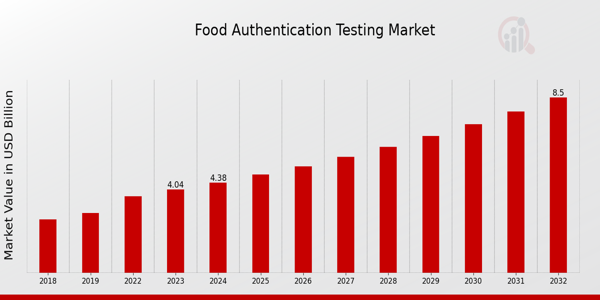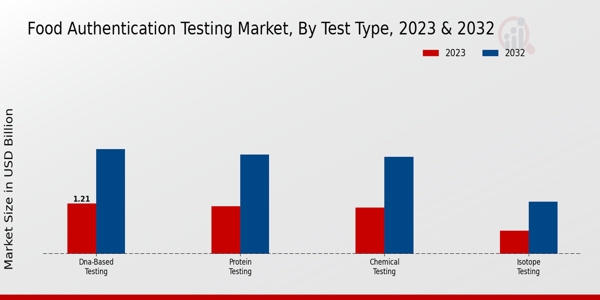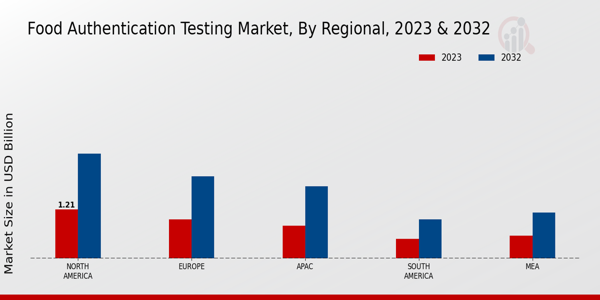Global Food Authentication Testing Market Overview
Food Authentication Testing Market Size was estimated at 3.72 (USD Billion) in 2022. The Food Authentication Testing Industry is expected to grow from 4.04(USD Billion) in 2023 to 8.5 (USD Billion) by 2032. The Food Authentication Testing Market CAGR (growth rate) is expected to be around 8.62% during the forecast period (2024 - 2032).

Source: Primary Research, Secondary Research, MRFR Database and Analyst Review
Key Food Authentication Testing Market Trends Highlighted
The Food Authentication Testing Market consists of the rising demand for food safety and food identity by various individuals and entities. Over the past decade, fraud regarding food authenticity has increased alarmingly, and this has led many governing bodies to put forward stricter measures and safety precautions. There is a growing concern people have in regard to the quality and source of food products, which creates a market for testing services. The increasing popularity of organic and sustainably grown foods increases the emphasis on reliable authentication methods as well. Testing services are becoming a priority for retailers and manufacturers as they want to enhance brand loyalty and prevent damage to their integrity.
There are significant market gaps that can be filled, given the rapid pace technology is evolving. Rapid analytical methods and the application of blockchain for product traceability are two highly compatible innovative testing concepts that should be integrated into the general authentication process. New markets are also starting to utilize food testing services, which creates new opportunities for businesses to grow their market. The partnership of technology companies and testing facilities can result in more effective solutions. The trend of most cases focusing on the introduction of comprehensive testing protocols has been observed in recent years. Most stakeholders now integrate a multi-technology approach combining DNA techniques with chemical analysis.
Also, an emerging tendency is creating mobile testing devices in order to improve the immediacy of response. Moreover, the growing focus on sustainability and ethical sourcing is making food authentication even more important. With consumers increasingly requiring reassurance about food choices made, the attention to food authenticity should remain and mature, therefore creating a demand for new technologies in testing and services.
Food Authentication Testing Market Drivers
Increasing Demand for Food Safety and Quality Assurance
The rising concern among consumers about food safety and quality has become a major driver for the Food Authentication Testing Market Industry. As foodborne illnesses and contamination cases gain widespread attention, there is a growing expectation for food producers and suppliers to ensure the integrity of their offerings. Consumers are becoming more informed and are demanding transparency regarding the origins and authenticity of the food products they consume.This demand for safety and quality drives the need for stringent food authentication testing as businesses strive to meet regulatory requirements and consumer expectations. As a result, companies are investing in advanced food authentication testing technologies and methodologies to ensure the traceability and reliability of their products. In an ever-evolving global market where food supply chains are complex and diverse, the significance of reliable food authentication testing cannot be overstated.The need for high-quality ingredients, accurate labeling, and verification of food sources is paramount. The awareness of ethical sourcing has also led to increased scrutiny of food products, prompting manufacturers to adopt robust testing measures to assure customers of the legitimacy of their offerings. Overall, this increasing demand for food safety and quality assurance is fostering growth in the Food Authentication Testing Market. This trend is not expected to diminish anytime soon, as the focus on health, safety, and quality continues to shape consumer behaviors and influence purchasing decisions.
Regulatory Frameworks and Compliance
The establishment of stringent food safety regulations and compliance mandates has emerged as a significant driver for the Food Authentication Testing Market Industry. Governments around the world are implementing more rigorous laws and standards to ensure the safety, authenticity, and traceability of food products. Compliance with these regulations is not just optional for food producers but a necessity to maintain market access and consumer trust.As regulatory bodies demand more robust testing and verification processes, businesses are compelled to seek reliable food authentication testing solutions to adhere to these requirements. The pressure to comply with local and international food safety standards drives investment in testing technologies, fostering the expansion of the market.
Rising Incidence of Food Fraud
The increasing incidents of food fraud have gained significant attention across the food industry, making it a crucial driver for the Food Authentication Testing Market Industry. Cases of adulteration and mislabeling not only undermine consumer trust but also pose health risks and economic challenges. As incidents of food fraud increase, both consumers and regulatory bodies are demanding more rigorous testing and verification processes to ensure the authenticity of food products.
Food Authentication Testing Market Segment Insights
Food Authentication Testing Market Test Type Insights
The Food Authentication Testing Market is experiencing significant growth, driven by an increasing consumer demand for food safety, authenticity, and quality assurance. Within the Test Type segment, various methodologies are employed to validate food products, with DNA-Based Testing, Protein Testing, Chemical Testing, and Isotope Testing each playing crucial roles. In 2023, DNA-Based Testing emerged as a dominant force, valued at 1.21 USD Billion, and it is expected to rise to 2.52 USD Billion by 2032, reflecting its majority holding in ensuring the accuracy of species identification and verification of genetically modified organisms in food.Protein Testing, another key component, held a market value of 1.15 USD Billion in 2023 and is projected to grow to 2.39 USD Billion by 2032. This segment is significant as it aids in verifying ingredient authenticity and detecting food adulteration, which is critical in maintaining consumer trust. Chemical Testing, valued at 1.12 USD Billion in 2023, is anticipated to grow to 2.33 USD Billion by 2032, providing vital data for detecting chemical residues and contaminants in food products.
Lastly, Isotope Testing, while the smallest segment, with a value of 0.56 USD Billion in 2023, is essential for verifying the geographical origin of food products; it is poised to expand to 1.26 USD Billion by 2032.This growing importance of Isotope Testing underscores the rising demand for traceability in supply chains. Overall, the segmentation reveals a well-rounded landscape in the Food Authentication Testing Market, with each test type contributing to the overall integrity of food safety and consumer protection.

Source: Primary Research, Secondary Research, MRFR Database and Analyst Review
Food Authentication Testing Market Food Type Insights
The Food Authentication Testing Market reached a valuation of 4.04 billion USD in 2023, underscoring the importance of ensuring food integrity across various types. The Food Type segment encompasses critical areas, including Meat and Meat Products, Dairy Products, Cereals and Grains, Fruits and Vegetables, and Beverages, each playing a pivotal role in overall revenue generation. For instance, the increasing stringency in food safety regulations and rising consumer awareness regarding food authenticity have significantly driven the demand for testing in Meat and Meat Products, which dominate the market due to their susceptibility to adulteration and mislabeling. Dairy Products also stand out given their health implications, leading to a notable focus on ensuring quality and origin.
Additionally, Cereals and Grains, as staple foods, require authentication to prevent economic fraud, while Fruits and Vegetables are increasingly scrutinized due to concerns over pesticide residues and organic labeling. Beverages are witnessing similar trends as consumers prefer authentic and sustainable sourcing. As these segments contribute to the market growth in the coming years, understanding the specific requirements of each type will be crucial for stakeholders within the Food Authentication Testing Market industry.
Food Authentication Testing Market Technology Insights
The Food Authentication Testing Market within the technology segment is poised for substantial growth, with a valuation of 4.04 billion USD in 2023 and projected to reach 8.5 billion USD by 2032. The increasing need for food safety, traceability, and quality assurance in the food supply chain drives this growth. Technologies such as Polymerase Chain Reaction (PCR) and Mass Spectrometry are pivotal in identifying foodborne pathogens and contaminants, significantly enhancing food safety standards. Enzyme-linked immunosorbent Assay (ELISA) plays a crucial role in detecting allergens and toxins, thus protecting consumer health and ensuring compliance with regulatory standards.Additionally, Nuclear Magnetic Resonance (NMR) stands out for its ability to deliver precise information on food composition and authenticity. Each of these technologies supports the food industry by enabling faster and more accurate testing methods, thereby facilitating the market growth. As consumers become more health-conscious and regulatory pressures increase, the demand for advanced testing technologies continues to rise, presenting numerous opportunities for innovation and development. The Food Authentication Testing Market data showcases an optimistic outlook as these technological advancements continue to reshape the industry landscape.
Food Authentication Testing Market End-Use Insights
The Food Authentication Testing Market has been witnessing significant growth, influenced by the diverse End Use segments, which include Food Manufacturers, Research Institutions, Government Agencies, and Retailers. In 2023, the market reached a valuation of 4.04 USD Billion, reflecting the increasing demand for food safety and quality assurance. Food Manufacturers play a critical role by ensuring that products meet stringent standards, thereby contributing to market growth. Research Institutions are essential for developing advanced testing methodologies and fostering innovation in the market.Government Agencies are key players, enforcing regulations and standards that drive the necessity for food authentication. Retailers also significantly impact the market, necessitating transparency and authenticity for consumer trust, ultimately leading to a higher market demand. The growth of these segments is propelled by trends emphasizing food safety, supply chain transparency, and increasing consumer awareness regarding food fraud. In addition to growth drivers, challenges such as regulatory hurdles and technology integration may affect market dynamics.Nonetheless, opportunities abound as emerging markets and new testing technologies open up avenues for expansion and enhancement within the Food Authentication Testing Market industry.
Food Authentication Testing Market Regional Insights
The Food Authentication Testing Market reached a valuation of 4.04 USD Billion in 2023, with significant contributions from various regions. North America stands out with a valuation of 1.212 USD Billion, reflecting its majority holding in the market due to stringent regulations and high consumer awareness regarding food safety. Europe follows closely with a valuation of 0.97 USD Billion, demonstrating a strong emphasis on food quality and labeling compliance. APAC is valued at 0.808 USD Billion, showcasing rapid growth driven by increasing food production and urbanization.South America, valued at 0.485 USD Billion, indicates a rising awareness of food authenticity amid evolving consumer preferences. The MEA region holds a value of 0.566 USD Billion, where market growth is supported by improving infrastructures and regulatory frameworks. With the highest anticipated growth rate, North America and Europe dominate the Food Authentication Testing Market, while APAC presents considerable opportunities for expansion, highlighting the diverse landscape of this vital industry.

Source: Primary Research, Secondary Research, MRFR Database and Analyst Review
Food Authentication Testing Market Key Players and Competitive Insights
The competitive landscape of the Food Authentication Testing Market is characterized by a surge in demand for food safety and quality assurance, driven by consumer awareness and regulatory pressures. Companies operating in this market aim to ensure that the food products and their ingredients meet specified authenticity standards, which is essential to combat fraud and maintain consumer trust. The landscape is increasingly dominated by key players who are focusing on technological advancements, improved testing methodologies, and expanded service offerings to stay ahead of the competition. The roles of collaboration and partnerships are also significant, as companies seek to enhance their capabilities and reach through strategic alliances. As this market evolves, factors such as geographical presence, specialized expertise, and innovative solutions play pivotal roles in determining competitive advantages among market players.DNV GL has established a robust presence in the Food Authentication Testing Market by offering a comprehensive suite of services aimed at ensuring food integrity and compliance with relevant regulations. The company's strengths lie in its extensive experience and expertise in risk management and quality assurance, allowing it to deliver precise and reliable testing solutions. DNV GL's commitment to sustainability and innovation further enhances its reputation as a trusted partner in food authentication. The company employs advanced testing technologies and methodologies that provide accurate results, contributing to minimizing risks associated with food fraud. Their global footprint enables them to serve clients across various regions, fostering a strong market presence in this competitive landscape. Furthermore, DNV GL's proactive approach to meeting changing regulatory requirements positions it favorably among customers who require consistent and reliable testing services.Intertek Group is another significant player in the Food Authentication Testing Market, renowned for its broad range of testing and certification services. The company's strength lies in its extensive global network, which allows it to deliver localized services while maintaining high standards across its offerings. Intertek Group focuses on providing innovative solutions tailored to the specific needs of the food and beverage sector, offering expertise in areas such as ingredient verification, supply chain management, and compliance testing. Its commitment to technological advancements ensures the use of cutting-edge methods for accurate and efficient testing processes. Intertek Group's reputation for reliability and integrity in testing services further solidifies its competitive position in the market. The company's ability to adapt to emerging trends and evolving consumer expectations contributes to its continued growth and success within the food authentication landscape.
Key Companies in the Food Authentication Testing Market Include
- DNV GL
- Intertek Group
- Bureau Veritas
- Eurofins Scientific
- QSI, Inc.
- Food Safety Net Services
- AsureQuality
- LGC Limited
- Applied DNA Sciences
- SGS
- Neogen Corporation
- Romer Labs
- Mérieux Nutrisciences
- Genetic ID
Food Authentication Testing Market Industry Developments
The Food Authentication Testing Market has witnessed notable developments recently, with companies like DNV GL, Intertek Group, Bureau Veritas, and Eurofins Scientific enhancing their service portfolios to meet growing consumer demand for food integrity. Regulatory pressures, especially in the European Union and North America, are intensifying, pushing firms to invest in advanced testing technologies to ensure compliance. In terms of mergers and acquisitions, QSI, Inc. has expanded its reach through strategic partnerships with various testing laboratories, while Food Safety Net Services strengthened its market position by acquiring select assets from regional testing firms, thereby enhancing its capabilities. AsureQuality has also been active, collaborating with LGC Limited to boost testing processes. The valuation of companies such as Applied DNA Sciences and Neogen Corporation has seen upward trends due to increased investment in innovative testing solutions, which, alongside these strategic moves, reflects a booming market environment. Meanwhile, SGS and Romer Labs continue to innovate to address challenges in traceability and transparency, responding to the evolving demands of consumers and regulatory bodies alike. Overall, these dynamics contribute to a robust and rapidly changing landscape in food authentication testing.
Food Authentication Testing Market Segmentation Insights
-
Food Authentication Testing Market Test Type Outlook
- DNA-Based Testing
- Protein Testing
- Chemical Testing
- Isotope Testing
-
Food Authentication Testing Market Food Type Outlook
- Meat and Meat Products
- Dairy Products
- Cereals and Grains
- Fruits and Vegetables
- Beverages
-
Food Authentication Testing Market Technology Outlook
- Polymerase Chain Reaction
- Mass Spectrometry
- Enzyme-Linked Immunosorbent Assay
- Nuclear Magnetic Resonance
-
Food Authentication Testing Market End-Use Outlook
- Food Manufacturers
- Research Institutions
- Government Agencies
- Retailers
-
Food Authentication Testing Market Regional Outlook
-
North America
-
Europe
-
South America
-
Asia-Pacific
-
Middle East and Africa
| Report Attribute/Metric |
Details |
| Market Size 2022 |
3.72(USD Billion) |
| Market Size 2023 |
4.04(USD Billion) |
| Market Size 2032 |
8.5(USD Billion) |
| Compound Annual Growth Rate (CAGR) |
8.62% (2024 - 2032) |
| Report Coverage |
Revenue Forecast, Competitive Landscape, Growth Factors, and Trends |
| Base Year |
2023 |
| Market Forecast Period |
2024 - 2032 |
| Historical Data |
2019 - 2023 |
| Market Forecast Units |
USD Billion |
| Key Companies Profiled |
DNV GL, Intertek Group, Bureau Veritas, Eurofins Scientific, QSI, Inc., Food Safety Net Services, AsureQuality, LGC Limited, Applied DNA Sciences, SGS, Neogen Corporation, Romer Labs, Mérieux Nutrisciences, Genetic ID |
| Segments Covered |
Test Type, Food Type, Technology, End Use, Regional |
| Key Market Opportunities |
Increasing food safety regulations, Rising consumer demand for transparency, Advancements in testing technologies, Growth in organic food market, Expansion of supply chain verification |
| Key Market Dynamics |
Growing food safety concerns, Stringent regulatory frameworks, Increasing consumer awareness, Advances in testing technologies, Rise of food fraud incidents |
| Countries Covered |
North America, Europe, APAC, South America, MEA |
Frequently Asked Questions (FAQ) :
The Food Authentication Testing Market is expected to be valued at 8.5 USD Billion in 2032.
The expected CAGR for the Food Authentication Testing Market from 2024 to 2032 is 8.62%.
North America holds the largest market share in the Food Authentication Testing Market, valued at 1.212 USD Billion in 2023.
DNA-Based Testing in the Food Authentication Testing Market is projected to be valued at 2.52 USD Billion in 2032.
Key players in the Food Authentication Testing Market include DNV GL, Intertek Group, Bureau Veritas, and Eurofins Scientific.
The expected market size of the Chemical Testing segment is 2.33 USD Billion in 2032.
The Food Authentication Testing Market is experiencing growth opportunities due to rising food safety concerns and regulatory frameworks.
The projected market size for the Isotope Testing segment in 2032 is 1.26 USD Billion.

















